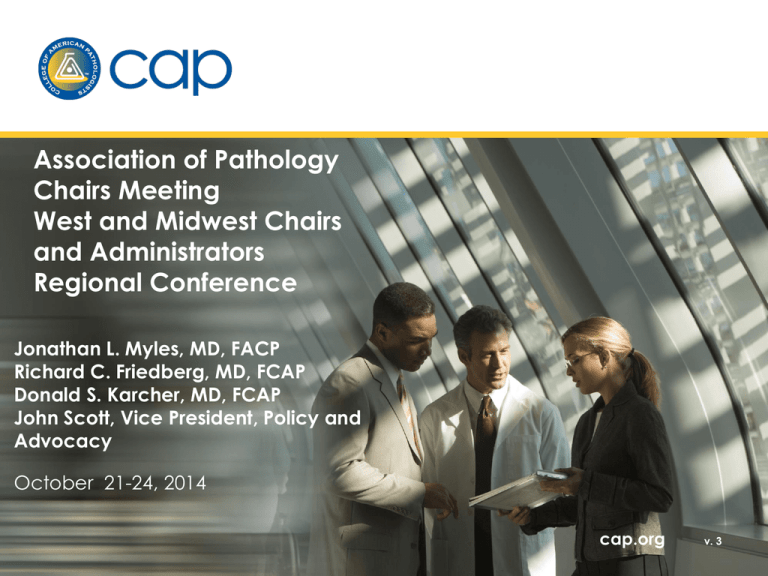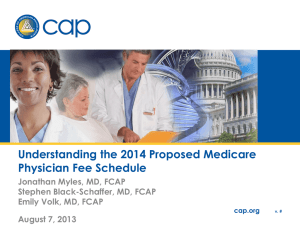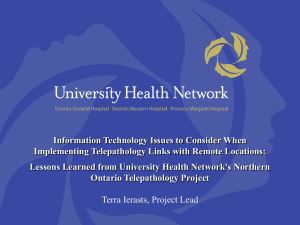
Association of Pathology
Chairs Meeting
West and Midwest Chairs
and Administrators
Regional Conference
Jonathan L. Myles, MD, FACP
Richard C. Friedberg, MD, FCAP
Donald S. Karcher, MD, FCAP
John Scott, Vice President, Policy and
Advocacy
October 21-24, 2014
cap.org
v. 3
Overview
• Current Fee Schedule
• Payment Reform on CLFS
• 2015 Proposed Rule
• Value Based Payment
• ACOs
• Bundling of Payment
• CAP Guidelines
© 2014 College of American Pathologists. All rights reserved.
2
Payment Sources for Medicare Patients
• DRG
• Physician Fee Schedule (PC and TC)
• Clinical Lab Fee Schedule (CLFS)
• APC
© 2014 College of American Pathologists. All rights reserved.
3
CPT Describes the Service
• MPAG (Molecular Pathology Advisory Group)
• PCC (Pathology Coding Caucus)
• CPT Editorial Panel
• CPT is HIPAA required code set for all payers, but
CMS can require use of Medicare-only G codes on
a case-by-case basis.
© 2014 College of American Pathologists. All rights reserved.
4
Valuation of Services
• AMA-RUC (Relative Value Update Committee)
makes recommendations for codes on the PFS,
resource based system.
• CLFS codes are valued by crosswalking or gapfill
process.
• CMS makes final determination
© 2014 College of American Pathologists. All rights reserved.
5
Medicare Payment Schedule
What are the proposed rule and final rule?
© 2014 College of American Pathologists. All rights reserved.
6
Protecting Access to Medicare Act of 2014
(PAMA)
• President signed PAMA into law on April 1, 2014
• Delays 24% physician fee cuts until March 2015
• Represents 17th temporary “fix” to SGR
physician pay formula
• Ends hope of permanent repeal of SGR in 2014
• Bipartisan, bicameral repeal proposal would
have addressed pathologists’ challenges in
current CMS pay-for-performance systems
© 2014 College of American Pathologists. All rights reserved.
7
PAMA a “Mixed Bag” for Laboratory Medicine
• PAMA temporarily delays the 24% SGR cut,
which affects all physicians
• But expands the Misvalued Codes Initiative, will
likely target more pathology services
• Significant changes to Clinical Laboratory Fee
Schedule (CLFS) used as “pay-for”
• CLFS changes will have significant (unknown)
impact on laboratories
• But may mitigate some challenges with
payments for molecular pathology services
© 2014 College of American Pathologists. All rights reserved.
8
Expands Misvalued Code Initiatives
• Further expands CMS’ misvalued code
authority starting in 2017
• Threatens pathology by targeting:
o Codes billed in multiple units
o Codes with low RVUs billed together
o Codes with payment differences across
sites of service
© 2014 College of American Pathologists. All rights reserved.
9
Context for CLFS Reform
• CLFS payments based on 1984 prices, updated
(rarely) for inflation
• 2013 OIG study: Medicare paid 18-30 % more
than private payers for 20 high-volume
laboratory tests
• 2014 Final Rule outlined CMS plan to re-value
1,200 laboratory tests paid on CLFS
• Payment revisions based on “technological
changes” were to start January 2015, continue
for five years
© 2014 College of American Pathologists. All rights reserved.
10
Payment Changes for Clinical Laboratory Tests
• PAMA stopped CMS plan for re-valuing CLFS
• New law limits clinical lab cuts to:
o 10% for 2017-2019
o 15% for 2020-2022
• Analysts estimate PAMA’s CLFS changes will
save Medicare $2.5 billion over next
decade.
© 2014 College of American Pathologists. All rights reserved.
11
Timeline for CLFS Reform
• Jan 1, 2016: “Applicable laboratories” must
report data on private payer payment rates
and test volumes
• Jan 1, 2017: New CLFS rates will apply;
based on weighted median of private
payment rates
• Proposed rule to be issued on the process by
June 2015
© 2014 College of American Pathologists. All rights reserved.
12
“Applicable Laboratories”
Required to Report Data
• All laboratories for whom CLFS or MPFS payments >
50% of Medicare revenue
• Hospital DRG, APC payments excluded
• Included: Physician practices, hospital outpatient as
well as independent laboratories
• But reporting requirement refers only to CLFS tests,
not payments for AP
• CMS has ability to set low-volume or low-spending
thresholds
• Penalties of up to $10,000 per day for failure to
report data; laboratory officer must certify
© 2014 College of American Pathologists. All rights reserved.
13
Advanced Diagnostic Laboratory Tests
• Law creates new “fast track” HCPCS codes
• “Advanced diagnostic laboratory tests” are solesource tests that:
o Analyze multiple biomarkers using unique
algorithmic analysis or
o Are cleared or approved by FDA or
o May include other types (up to CMS)
• Tests will be paid market price from Jan to Sept, 2017
• CMS will then determine rates based on lab’s annual
reporting of private payer rates
© 2014 College of American Pathologists. All rights reserved.
14
PAMA Addresses Some Concerns About
Molecular Pathology
• MACs are required to abide by the existing
local coverage determination (LCD) process
when issuing coverage decisions effective Jan
1, 2015
• Expert Advisory Panel will consult with CMS on
coverage, payment decisions
• CMS must explain methods for the payment
rates it determines under the crosswalking and
gapfilling methods
• Intended to address stakeholder concerns
about transparency of gapfilling in 2013
© 2014 College of American Pathologists. All rights reserved.
15
PAMA CONCERNS
• Who reports?
• Ease of reporting and how can this be done given
existing statute?
• What is a payment?
• Medicaid managed care payments
• Consolidation of MAC’s
• Expert Advisory Panel
© 2014 College of American Pathologists. All rights reserved.
16
2015 Proposed Rule
• CMS plans to streamline process for making local
coverage decisions (LCDs); end Carrier Advisory
Committee (CAC) reviews of every LCD.
© 2014 College of American Pathologists. All rights reserved.
17
Proposed 2015 Medicare Physician Fee Schedule
• CMS’ proposed fee schedule estimates 1% increase
in pay to pathologists (PC, TC, global) in 2015 based
on PE cuts proposed for other specialties.
• Independent laboratories, a 3% increase
• However, CMS’ estimates will likely change in the
final fee schedule.
© 2014 College of American Pathologists. All rights reserved.
18
CMS Initiative to Revalue High-Volume Services
• Passage of the Affordable Care Act empowered
CMS to review reimbursement for all high-volume
physician services.
• Allows agency to redistribute funds to primary care
• Review of high-volume pathology codes flagged by
CMS in 2011 continues in 2015 and beyond.
• 1,200 codes, many from other specialties, have
been reviewed.
© 2014 College of American Pathologists. All rights reserved.
19
2015 Fee Schedule: Specific Pathology Services
• Prostate biopsy codes
o If accepted, proposal effective January 1, 2015
o CMS proposes to use one G code (G0416) to
report prostate biopsy services, regardless of
number of specimens
o Applies to all prostate biopsy specimens,
including 1-9
o Other prostate G codes and 88305 would no
longer be used to report prostate biopsies
o CMS believes the service is misvalued
o CMS seeks input on future payment levels
© 2014 College of American Pathologists. All rights reserved.
20
2015 Fee Schedule: Specific Pathology Services
• Link pathology payment rates to hospital rates
o CAP persuaded CMS to withdraw the proposal in
2013, but the agency plans to bring it back.
o PAMA expands legal authority to review
payments across sites of service.
o No 2015 payment changes based on site of
service, but CMS did request more information.
o CMS seeks comment on utilizing hospital cost
data for valuing payment for physician services.
© 2014 College of American Pathologists. All rights reserved.
21
2015 Fee Schedule: Specific Pathology Services
• CAP continues its opposition to linking
payments to hospital rates
o CMS review could cause 2015 TC/global
payment changes
o CAP to CMS – hospital cost data unworkable
for determining PFS pay rates
© 2014 College of American Pathologists. All rights reserved.
22
2015 Fee Schedule: Misvalued Codes
• Pathologists already have had global payment for
28 codes revalued.
• Practice expense for TC of 22 additional codes also
reviewed for 2015.
• CMS added 80 codes to its misvalued list
• 1 pathology service
o 88185, add-on code used to bill the TC of flow
cytometry
© 2014 College of American Pathologists. All rights reserved.
23
2015 Fee Schedule: Transparency in Ratesetting
• CMS proposes to alter process for changing
reimbursement for codes identified in the misvalued
code initiative.
o Proposal would increase transparency
o CMS would only set physician rates after the
public had an opportunity to comment.
• This would avoid situations like the process for the
IHC G code policy in 2014.
• 2016 implementation of transparency proposal
anticipated.
© 2014 College of American Pathologists. All rights reserved.
24
CMS Initiative to Revalue High-Volume Services
• Immunohistochemisty
o CMS created G codes for 2014
o CAP advocating for alternative to G codes
o Await final rule
© 2014 College of American Pathologists. All rights reserved.
25
CMS Initiative to Revalue High-Volume Services
• In Situ Hybridization Services
o Action deferred on revaluation for 2014 payment
rates
o Payment changes anticipated for 2015
o CAP is engaged in NCCI coding edit relief
© 2014 College of American Pathologists. All rights reserved.
26
2015 Fee Schedule: PQRS
• CMS proposes accepting three new pathology
measures developed by the CAP to the Physician
Quality Reporting System (PQRS).
o Lung cancer reporting (biopsy/cytology)
o Lung cancer reporting (resections)
o Melanoma reporting
• Increases number of pathology measures to eight
• CAP will provide education on reporting 2015 PQRS
measures after the final rule is published.
© 2014 College of American Pathologists. All rights reserved.
27
2015 Fee Schedule: PQRS
• In 2014, PQRS reporting activity will determine which
physicians receive a payment penalty in 2016.
• CMS proposes to take a similar approach in 2015
with PQRS reporting affecting 2017 payments.
• 2017 PQRS penalty = 2%
o Penalty is based on 2015 PQRS activity
• Eligible physicians must report on nine measures, or
on all that apply to their practices, to avoid the
penalty.
© 2014 College of American Pathologists. All rights reserved.
28
2015 Fee Schedule: Value-Based Modifier
• Apply to all physicians in 2017
o However, modifier is based on 2015 performance
• Penalty increases to 4%; bonuses up to 4% or higher
• No negative adjustment to physicians in groups < 10
if they successfully report PQRS measures
• Groups with 10 or more eligible professionals
subject to quality tiering.
• CAP has proposed an alternative methodology
© 2014 College of American Pathologists. All rights reserved.
29
2015 Fee Schedule: Value-Based Modifier
• CMS alluded to the CAP proposal in the fee
schedule
• CMS is considering allowing hospital-based
physicians to use the hospital value-based
purchasing program in future years.
o The hospital value-based purchasing program
could be a component of the VBM calculation.
• CMS would propose any changes in future
rulemaking.
o How hospital performance would be included?
© 2014 College of American Pathologists. All rights reserved.
30
2015 Fee Schedule: 2017 PQRS and VBM Penalties
• Failure to report PQRS in 2015 could mean a
-6% payment adjustment in 2017 for eligible
pathologists.
• Reporting PQRS measures stops the VBM and
PQRS penalties
-2%
-6%
-4%
© 2014 College of American Pathologists. All rights reserved.
31
2015 Proposed Rule
• CMS considers expanding processes of the MolDx
program to making decisions on all clinical
diagnostic laboratory tests.
© 2014 College of American Pathologists. All rights reserved.
32
Continuing Challenges
• Integration into Value Based Payment System
• What will be the role of Fee for Service?
• ACOs
• Bundling
© 2014 College of American Pathologists. All rights reserved.
33
What can I do?
• Know what tests you perform and what fee
schedule they are billed under.
• Be involved
© 2014 College of American Pathologists. All rights reserved.
34
Meeting Practice Challenges: Overview of CAP
Initiatives
• CAP Guidelines
• Policy Roundtable
• ACO Network
• Engaging with
Medicare Contractors
and Private Insurers
• Blood Utilization
© 2014 College of American Pathologists. All rights reserved.
35
CAP Guidelines – Coming Soon
•
Publications expected in Q1 2015
o CAP/NSH Uniform Labeling Requirements for
Blocks and Slides in Surgical Pathology
o CAP/ADASP Interpretive Diagnostic Error
Reduction in Surgical Pathology and
Cytopathology
•
Open Comment Periods
o CAP/ASH Algorithm for the Initial Work-up of
Acute Leukemia (Q4 2014)
o ASCP/CAP/AMP/ASCO Molecular Markers for the
Evaluation of Colorectal Cancer (Q1 2015)
© 2014 College of American Pathologists. All rights reserved.
36
CAP Evidence-Based Clinical Practice
Guidelines
• Published by the CAP Pathology and Laboratory
Quality Center
• Improve and standardize laboratory practices,
leading to better patient outcomes
• Collaborate with other pathology and medical
associations, such as ASCO, AMP, and ADASP
• Published seven guidelines with 11 in development
• Visit cap.org CAP Reference Resources and
Publications > CAP Guidelines
Pathologists can take the lead by implementing CAP
guidelines at their institutions.
© 2014 College of American Pathologists. All rights reserved.
37
CAP Guidelines: Extending the Reach
• Received grant for $1.25MM
from the CDC to improve
guideline adoption
• Endorsed by ASCO:
CAP/IASLC/AMP
lung cancer biomarker
guideline
o Published in the Journal of
Clinical Oncology (JCO)
on Oct. 13, 2014
© 2014 College of American Pathologists. All rights reserved.
38
Policy Roundtable
•
3-to-5 Year Research
Agenda
© 2014 College of American Pathologists. All rights reserved.
•
Data Collection and
Analysis
•
Policy Research
•
GME
o Workforce Demand
Paper
39
PRT Survey Efforts
Practice
Characteristics
Survey
• Economic and
practice patterns of
individual
pathologists
Pathologist
Training Survey
• Assess how well
training meets needs
of new pathologists
and their employers
Practice
Leaders Survey
• Economic and
practice patterns of
pathology practices
© 2014 College of American Pathologists. All rights reserved.
40
Pathologist Training Surveys
For each of 40 different pathology practice areas,
respondents are asked to rank:
• How important is knowledge/skill in the practice
area to performance in your current role?
Critically Important
Very Important
Important
Slightly important
Unimportant
NA/No responsibilities
• Considering your responsibilities in the area, how
would you rate the amount of training you received
in your residency training program?
Much more than
practically useful
Somewhat more than About Right
practically useful
Somewhat less than
practically useful
Much less than
practically useful
© 2014 College of American Pathologists. All rights reserved.
No Training
41
Practice Leader Survey
• Understand Practice
Level data on Key
issues Facing
Pathologists
• Understand how those
issues vary by
o Type of setting
o Type of practice
o Practice Size
o Other key variables
• Establish baseline for
identifying trends over
time
© 2014 College of American Pathologists. All rights reserved.
42
Accountable Care Organizations
• Health care organizations that accept
accountability for the . . .
o Quality of care
o Health of the population served
o Per capita cost of care for a designated
population
• Formed by combination of providers and/or
hospitals
43
Accountable Care Organizations
HMOs by another name?
HMO
ACO
??
+
2. Improved health for the population*
?
+
3. Lower costs*
+
+
1. Better quality care for individuals*
* HIT can now facilitate all three
44
Accountable Care Organizations
Total Number of ACOs – 1/14
45
Accountable Care Organizations
Structure of ACOs – 1/14
46
Accountable Care Organizations
Total Covered Lives in ACOs – 1/14
47
Accountable Care Organizations
% Covered Lives in ACOs by Hospital Region – 1/14
48
Accountable Care Organizations
Different Models – 6/14
• CMS Medicare Shared Savings Program (MSSP)
ACOs……………………………..338
• CMS CMMI Pioneer ACOs……..23
• Medicaid ACOs……………………7 states
• Private sector ACOs…………...250+
Total
620+
49
Pathologists and ACOs
Challenges:
• Establish value-added roles in support of ACOs
• Gain recognition for these roles
• Get paid fairly for these roles
© 2014 College of American Pathologists. All rights reserved.
50
Pathologists and ACOs
From the 2014 CAP Practice Characteristics Survey:
• Number of pathologists currently participating or
negotiating to participate in one or more ACOs
o 20% (8% in 2011)
• Does your ACO provide you with distribution of
shared savings and/or incentive payments?
o Yes – 38%
o No – 31%
o Don’t know – 31%
© 2014 College of American Pathologists. All rights reserved.
51
CAP’s ACO Network
• CAP launched the ACO
Network over three years ago
• Serves as vehicle for bidirectional communication
among pathologists in ACOs
• CAP ACO Network continues to
grow
• Triple the size at launch
• New resources and tools
being developed
© 2014 College of American Pathologists. All rights reserved.
52
CAP’s ACO Network
• CAP Tools Available
o Case studies
o Best practice webinars
o CAPconnect community
• Join the network by sending us
an email
o ACO@cap.org
• ACO Resource Center:
www.cap.org/accountablecare
© 2014 College of American Pathologists. All rights reserved.
53
Advocacy with Local Medicare Contractors and
Private Payers
• Longstanding CAP advocacy work with local
Medicare contractors and private payers regarding
coverage decisions
• Palmetto
• Palmetto Removes Special Stains, IHC Article
After Discussions With CMS
• United
• UnitedHealthcare Moves Ahead, But Delays
Beacon Pilot Enforcement Date
© 2014 College of American Pathologists. All rights reserved.
54
Test Utilization
• Utility and Cost-Effectiveness of H.pylori
Immunostains vs Special Stains is currently in
development and is among first of CAP’s Pathology
Practice Guidances (PPG).
• Council on Scientific Affairs Working Group
• Exploring best practices & developing
recommendations
• Created preliminary needs assessment survey
© 2014 College of American Pathologists. All rights reserved.
55
Test Utilization
• Quality Practices
Committee examining
Current CAP member
test utilization practices
• CAP collaborating with
the Clinical Laboratory
Standards Institute on
joint publication
© 2014 College of American Pathologists. All rights reserved.
56
Laboratory-Developed Test (LDT) Oversight
• CAP principles for LDT oversight:
o Assure quality laboratory testing for patients
o Allow for innovation
o Prevent undue administrative or regulatory
burdens
• Principles captured in the CAP’s oversight proposal
• FDA proposed its oversight guidance on Sept 30
• The CAP will continue to be engaged with the FDA
during a four-month comment period
© 2014 College of American Pathologists. All rights reserved.
57
Laboratory-Developed Test (LDT) Oversight
• Similarities:
• Analytic, clinical validation
o Addresses public health concerns
• FDA proposes three-tiered approach to oversight
o Based on risk (low, moderate, high)
• CAP called for enforcement discretion for low-risk
LDTs
• FDA oversight focuses on high-risk LDTs
© 2014 College of American Pathologists. All rights reserved.
Laboratory-Developed Test (LDT) Oversight
Differences:
• CAP proposed that moderate- and low-risk LDTs be
regulated by CMS
o FDA proposes it assumes all authority
• FDA definition of LDTs is narrower
o Forces more tests to go through clearance
• FDA definition of high-risk is broader
o Subjecting more tests to premarket approval
© 2014 College of American Pathologists. All rights reserved.
59








